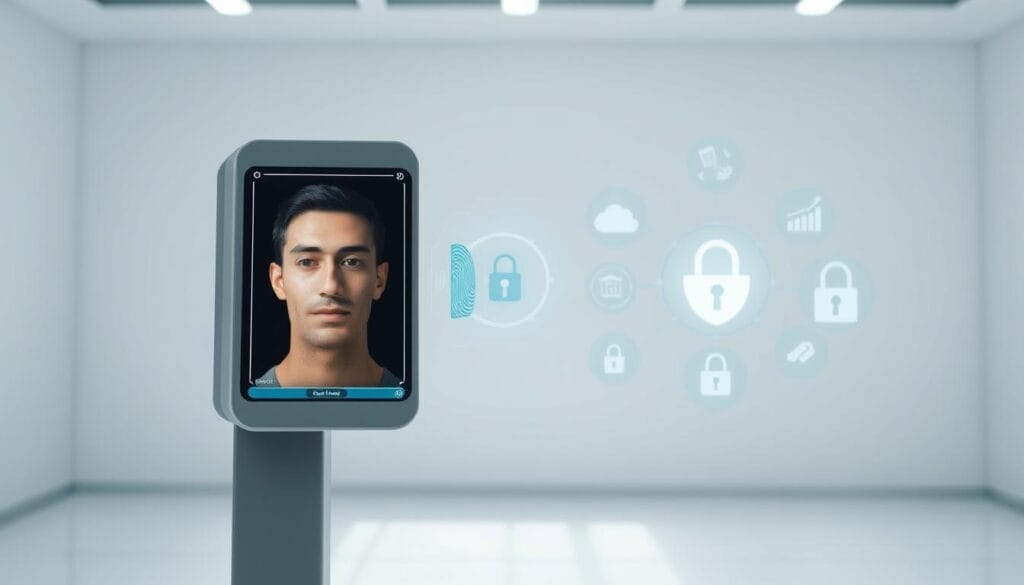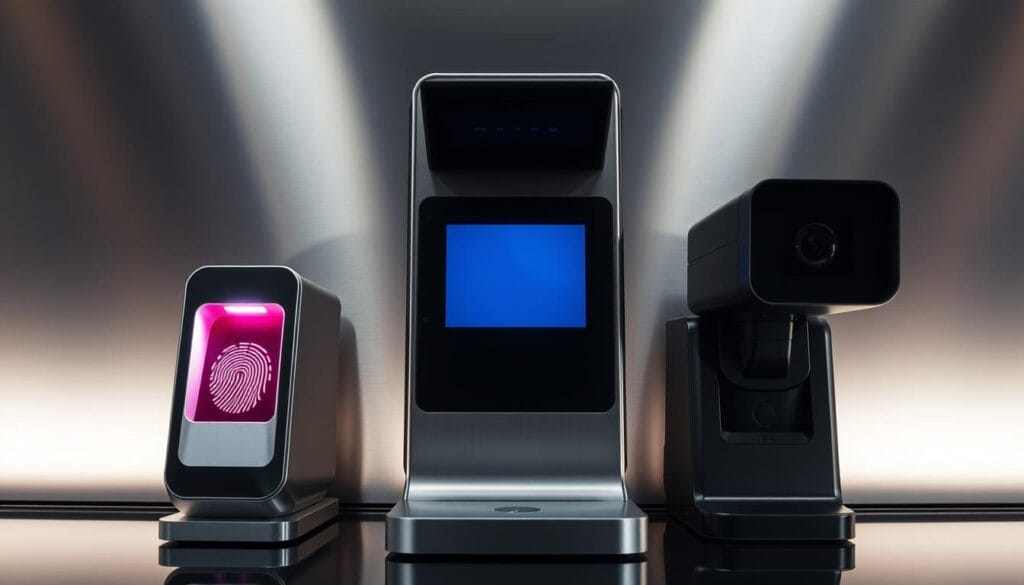Over 70 billion automated checks occurred globally in 2024 to confirm client legitimacy—a figure surpassing the world’s population by nearly tenfold. This staggering number underscores a seismic shift in how financial institutions manage trust and compliance. Traditional methods, like in-person document reviews, are being replaced by streamlined systems that prioritize speed without compromising safety.
Financial organizations now face unprecedented pressure to balance user convenience with fraud prevention. Automated validation tools have become central to this effort, enabling real-time approvals while reducing human error. Institutions leveraging these solutions report 30% faster onboarding and 52% fewer security breaches compared to outdated approaches.
Emerging tech trends—from biometric authentication to blockchain-based credentials—are redefining what “secure access” means. These innovations not only protect sensitive data but also position forward-thinking banks as industry leaders. However, adapting to evolving regulations remains critical as governments tighten oversight to combat cybercrime.
Key Takeaways
- Automated validation processes now handle billions of checks annually, replacing manual workflows.
- Enhanced security protocols directly correlate with improved customer retention rates.
- Biometric and AI-driven systems are becoming standard for fraud detection.
- Regulatory compliance will heavily influence tech adoption through 2025.
- Banks prioritizing seamless onboarding gain measurable competitive advantages.
Overview of Digital Identity Verification

Confirming an individual’s legitimacy once required stacks of paperwork and weeks of waiting. Today, advanced systems analyze biometric markers and cross-reference global databases in seconds. This transformation reflects two decades of technological advancement, reshaping how organizations establish trust.
Definition and Evolution
Modern validation methods involve confirming credentials through automated checks rather than manual reviews. Early systems relied on physical document inspections, which were time-consuming and prone to errors. The shift began with optical character recognition for scanning IDs, later integrating AI to detect forged details.
Biometric tools like facial recognition and fingerprint analysis now supplement traditional approaches. These innovations address vulnerabilities in older models while accelerating decision-making. For instance, liveness detection ensures submitted materials aren’t recycled from previous fraud attempts.
Significance in Financial Operations
Financial institutions increasingly depend on these systems to meet regulatory demands and customer expectations. By automating checks, they reduce onboarding time from days to minutes. A 2023 Federal Reserve report noted institutions using AI-driven validation saw 40% fewer manual interventions.
Secure handling of sensitive materials remains critical. Systems encrypt details like Social Security numbers and passport scans, limiting exposure during transfers. This protects both organizations and clients while maintaining compliance with evolving privacy laws.
Digital Identity Verification in Banking 2025

Financial institutions are projected to process over 100 billion automated validation checks annually by 2025, driven by stricter compliance demands and escalating cyber threats. This surge reflects a broader shift toward tech-driven security frameworks that prioritize both efficiency and accuracy.
Trends and Growth Predictions
Industry analysts forecast a 220% increase in automated credential assessments compared to 2023 levels. Fraudulent activities now cost banks $42 billion yearly, accelerating investments in AI-powered fraud detection solutions. Liveness checks and blockchain-based validations are emerging as critical tools, reducing false approvals by 18% in early trials.
Adoption rates for automated KYC systems jumped 63% last year, with institutions reporting 40% faster account activation. These platforms cross-reference biometric data with global watchlists in milliseconds, minimizing delays. A Federal Trade Commission study found institutions using these methods reduced manual review workloads by 55%.
Impact on Customer Onboarding Processes
Streamlined processes now enable clients to open accounts in under four minutes through leading mobile banking platforms. Real-time document analysis flags discrepancies during submission, cutting error rates by 31%. This precision builds trust while meeting anti-money laundering requirements.
Biometric authentication replaces password-based logins at 74% of top U.S. banks, reflecting consumer demand for frictionless access. Institutions combining facial recognition with device-level security saw 27% higher onboarding completion rates. As regulations evolve, these systems adapt faster than legacy frameworks, future-proofing compliance efforts.
Technological Innovations and Security Measures

Financial service providers now deploy advanced systems combining biometric markers with artificial intelligence to combat sophisticated fraud tactics. These tools address vulnerabilities in legacy frameworks while accelerating secure transactions.
Biometric Authentication and Liveness Detection
Fingerprint scans and facial recognition now dominate user authentication workflows. JPMorgan Chase reported a 38% drop in account takeovers after implementing iris-scanning technology. Liveness detection adds critical protection by requiring real-time gestures like blinking or head movements during verification.
This approach prevents spoofing with photos or deepfakes. A 2024 Aite-Novarica study found institutions using these techniques reduced synthetic identity fraud by 47%. Citibank’s mobile app now incorporates passive liveness checks, eliminating manual prompts during video-based authentication.
AI-Powered Fraud Prevention
Machine learning algorithms analyze thousands of behavioral signals, from typing speed to device orientation. These systems flag anomalies like mismatched signatures or inconsistent document metadata. HSBC’s AI-driven platform identified 19% more high-risk transactions than rule-based models in Q1 2024 trials.
Natural language processing cross-references application details against global sanctions lists and emerging threat patterns. Bank of America’s document validation tool detects tampered passports with 99.1% accuracy, cutting manual review time by 62%.
These innovations create frictionless experiences without compromising safety. Customers complete transactions faster, while institutions maintain compliance with evolving security standards.
Regulatory Compliance and Global Standards

Global financial systems now operate under a complex web of regulations designed to prevent fraud and protect sensitive information. Institutions must navigate frameworks like GDPR and eIDAS while meeting regional mandates such as KYC and AML protocols. These rules dictate how organizations validate credentials, manage risk, and safeguard consumer data.
KYC and AML Requirements
Anti-money laundering laws require rigorous validation of government-issued IDs like driver licenses during client onboarding. Automated systems cross-reference these documents with sanctions lists and watchdogs’ databases in real time. Non-compliance risks penalties exceeding $20 million per violation, as seen in recent FTC enforcement actions.
Data Privacy and Consumer Trust
Strict privacy regulations demand encryption of personal details during checks, with 89% of clients prioritizing data security when choosing financial providers. Regular audits ensure systems align with ISO 27001 certifications, while biometric authentication systems—like those enabling secure transactions—reduce reliance on vulnerable password-based logins. A 2024 Deloitte study found institutions with GDPR-compliant processes retained 34% more customers annually.
Standardized procedures for handling IDs foster global interoperability, letting firms operate across borders without compromising compliance. As frameworks evolve, proactive adaptation remains critical to maintaining operational integrity and public confidence.
Challenges and Risks in the Evolving Landscape

Fraud losses in financial services exceeded $5.8 billion in 2023, driven by increasingly sophisticated attacks leveraging artificial intelligence. This escalation forces organizations to rethink security frameworks while maintaining operational efficiency. Outdated infrastructure and evolving fraud tactics create a dual challenge—protecting assets without sacrificing user experience.
Mitigating AI-Enabled Fraud Tactics
Cybercriminals now use generative AI to create forged documents and mimic voice patterns. A 2024 IBM Security report revealed that 43% of financial breaches involved AI-generated synthetic identities. Traditional methods struggle to detect these threats, requiring adaptive solutions like AI-driven anomaly detection that analyzes behavioral patterns in real time.
Leading institutions deploy neural networks to flag inconsistencies in application data. These systems process 12,000 data points per second—identifying subtle discrepancies humans often miss. For example, mismatched metadata in uploaded IDs now triggers instant alerts, reducing false approvals by 29%.
Addressing Scalability and Legacy Systems
Many organizations rely on decades-old infrastructure incompatible with modern security protocols. Upgrading these systems demands significant investment—JPMorgan spent $15 billion in 2023 alone on tech modernization. Hybrid approaches integrate cloud-based tools with existing frameworks, allowing gradual transitions without service disruptions.
Scalability remains critical as transaction volumes grow. Institutions handling 10 million daily validations require distributed architectures that minimize latency. Cloud-native platforms reduced processing times by 41% in stress tests, proving vital for maintaining compliance amid rising regulatory scrutiny.
Leveraging Digital Identity for Enhanced User Experience

Modern consumers expect instant access to services without compromising safety. Financial providers are responding by redesigning client interactions around speed and reliability, using advanced tools to simplify complex processes.
Streamlined Onboarding and Authentication
Leading banks now enable account creation in under three minutes using facial recognition and document scanning. Bank of America’s mobile app, for example, reduced application abandonment by 22% after introducing real-time ID validation. These systems automatically cross-check data against global registries, eliminating manual form submissions.
Biometrics like fingerprint scans replace traditional passwords, offering one-tap access to accounts. A 2024 J.D. Power study found 81% of users prefer apps with fingerprint login over typed credentials. This shift aligns with partnerships like eBankit’s collaboration with Prove, which integrates device-level security for frictionless transactions.
Building Customer Confidence
Secure authentication methods directly impact trust. Chase reported a 37% increase in mobile app usage after implementing iris-scanning technology. Systems that detect spoofing attempts—like AI analyzing subtle facial movements—reduce fraud risks while maintaining convenience.
Clients value transparency in how their data gets protected. Institutions sharing security features during onboarding see 28% higher satisfaction scores. As one Wells Fargo user noted, “Knowing my face unlocks my account makes me feel safer than remembering passwords.”
Balancing robust checks with intuitive design remains critical. Providers achieving this equilibrium gain loyal users who associate security with simplicity rather than inconvenience.
Real-World Implementation in Financial Services
Leading institutions now demonstrate how advanced credential management strengthens operational frameworks while meeting evolving security demands. These implementations reveal actionable insights for organizations navigating technical and regulatory complexities.
Case Studies and Best Practices
Citi reduced onboarding errors by 63% after integrating AI-powered document validation across 14 markets. Their system cross-references IDs with government databases while flagging inconsistencies in real time. “Automated checks cut manual review hours by 80%,” notes their Chief Risk Officer.
Wells Fargo adopted hybrid cloud solutions to manage 8 million monthly ID validations without overhauling legacy infrastructure. This approach improved processing speeds by 41% while maintaining GDPR compliance. Key best practices include:
- Phased integration of biometric authentication alongside existing password protocols
- API-driven connections between verification tools and core banking systems
- Regular audits to align document handling with ISO 27001 standards
Integration with Existing Systems
BBVA achieved seamless adoption by embedding liveness detection into mobile apps via modular SDKs. This allowed gradual feature rollouts while preserving user experience. Their solution now processes 12,000 daily checks with 99.4% accuracy.
Partnerships prove critical for scalable implementations. For example, a blockchain-based payment platform integrated with Mastercard’s ID network to verify cross-border transactions in under seven seconds. Such collaborations highlight how layered solutions address diverse verification challenges.
Future Outlook and Emerging Trends
By 2026, mobile driver’s licenses could replace physical IDs in 30% of U.S. states, accelerating a shift toward portable credentials stored in secure wallets like Apple Wallet. This evolution reflects growing consumer demand for unified authentication methods across government services and financial platforms.
Expansion of Mobile and Digital IDs
Financial organizations are piloting systems that validate credentials through encrypted mobile apps, eliminating document uploads. A 2024 Gartner report predicts 58% of banks will adopt smartphone-based validation by 2027, reducing onboarding steps from six to two. “Portable IDs enable real-time updates, making expired documents obsolete,” notes a Federal Reserve whitepaper.
Decentralized identifiers using blockchain technology are gaining traction. These systems let users control shared data—like age confirmation—without exposing sensitive details. Early adopters report 45% fewer data breaches compared to centralized databases.
Anticipated Regulatory and Technological Shifts
Lawmakers are drafting frameworks for cross-border recognition of electronic credentials. Proposed EU-U.S. agreements aim to standardize validation processes, addressing inconsistencies in current AML protocols. Non-compliant institutions risk exclusion from international payment networks.
AI will play dual roles—enhancing fraud detection while creating new threats. Quantum-resistant encryption and behavioral biometrics (analyzing typing rhythms) are emerging as countermeasures. For example, Mastercard’s trial system flags suspicious login attempts by detecting deviations in device handling patterns.
Businesses prioritizing these innovations will streamline compliance while building consumer trust. As one cybersecurity expert observes, “The race isn’t just against fraudsters—it’s about reshaping security as a competitive advantage.”
Conclusion
As financial threats grow more sophisticated, institutions must prioritize advanced methods to protect sensitive information while streamlining access. Automated systems now replace outdated passwords, using biometrics like facial recognition and liveness detection to verify identities in seconds. These tools address rising identity fraud costs—projected to exceed $42 billion annually—while accelerating onboarding processes.
Balancing security with convenience remains critical. Organizations leveraging advanced security tools automate document checks and cross-reference credentials without sacrificing speed. Real-time data analysis reduces manual errors by 31%, aligning with strict compliance standards like GDPR and AML protocols.
Future-ready frameworks rely on continuous innovation. Banks adopting AI-driven fraud detection report 40% fewer breaches, proving adaptability is key to long-term success. By integrating scalable solutions, businesses can maintain user trust while staying ahead of evolving risks—securing both assets and customer loyalty in an increasingly connected world.

